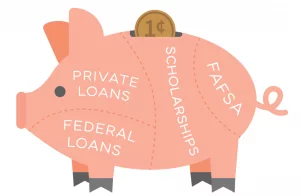When it comes to applying for college, figuring out financial aid, and everything in between, it can certainly feel as if there is an ever-growing list of acronyms to label each and every part of the process. There’s certainly no shortage of acronyms for various pieces of the FAFSA puzzle, and in this post, we will dive deep into a few of them.
Perhaps the most important one to know is EFC, otherwise known as Expected Family Contribution.
Your EFC is a monetary number that is calculated based on the financial information you submit on the FAFSA, and it is one of the measurements used to determine how much (and what types of) aid you will be eligible to receive.


Your EFC is calculated by college and university financial aid officers using a specific formula. The formula takes several key pieces of information (that you submit through your FAFSA) into account, including:
The actual formula that is used to calculate EFC is a complicated and intricate one. If you’re interested in learning about the logistics of how EFC is calculated for the FAFSA, this is your go-to resource!
All else aside, having a low EFC on the FAFSA means that you are eligible to receive more financial aid through the government and through your institution.
For the 2021-2022 school year, an EFC at or below $5,846 qualifies you to receive the federal Pell Grant, which is the government’s need-based grant for students with the highest levels of financial need.
Conversely, a high EFC means that you are eligible to receive less financial aid through the government and your institution.
This in turn means that you and your family will likely have to turn to other sources, such as private loans and private scholarships, in order to bridge the financial gap between your school’s COA (Cost of Attendance) and your family income.
Pro-tip: If you’re looking for some easy places to start with searching for private scholarships, check out some of my popular posts, like 50+ College Scholarships, Scholarships for High School Seniors, No-Essay Scholarships, Scholarships for Women, Full-Ride Scholarships, or Scholarships for College Freshmen.
There are dozens of more posts like these on my blog, so don’t hesitate to check them out.
In order to calculate how much need-based financial aid you are eligible to receive, the following formula can be used:
COA (Cost of Attendance) - EFC (Expected Family Contribution) = Need-based aid
You are not eligible to receive more financial aid than the amount that is calculated through this equation. As an example, say your COA is $30,000 and your EFC on the FAFSA is $10,000. This would mean that you are eligible for a maximum of $20,000 in need-based aid.
An important point that is worth clarifying in this section is that need-based aid does not only come in the form of grants and scholarships like the Pell Grant (which do not need to be repaid). It also includes direct subsidized loans, federal work-study, and more.
There are a few possible reasons as to why you might find yourself with a higher than expected EFC on the FAFSA, even if your family is considered low-income.
The first possible explanation is that your family likely has accumulated wealth and investments, such as money in checking and savings accounts, money in the stock market or in bonds, etc.
Another possible attributable factor to a higher EFC in this situation might be that you live in a state with a low state tax rate.
The easiest way to determine how much need-based financial aid you are eligible to receive before you’ve filed the FAFSA is to take advantage of an EFC calculator.